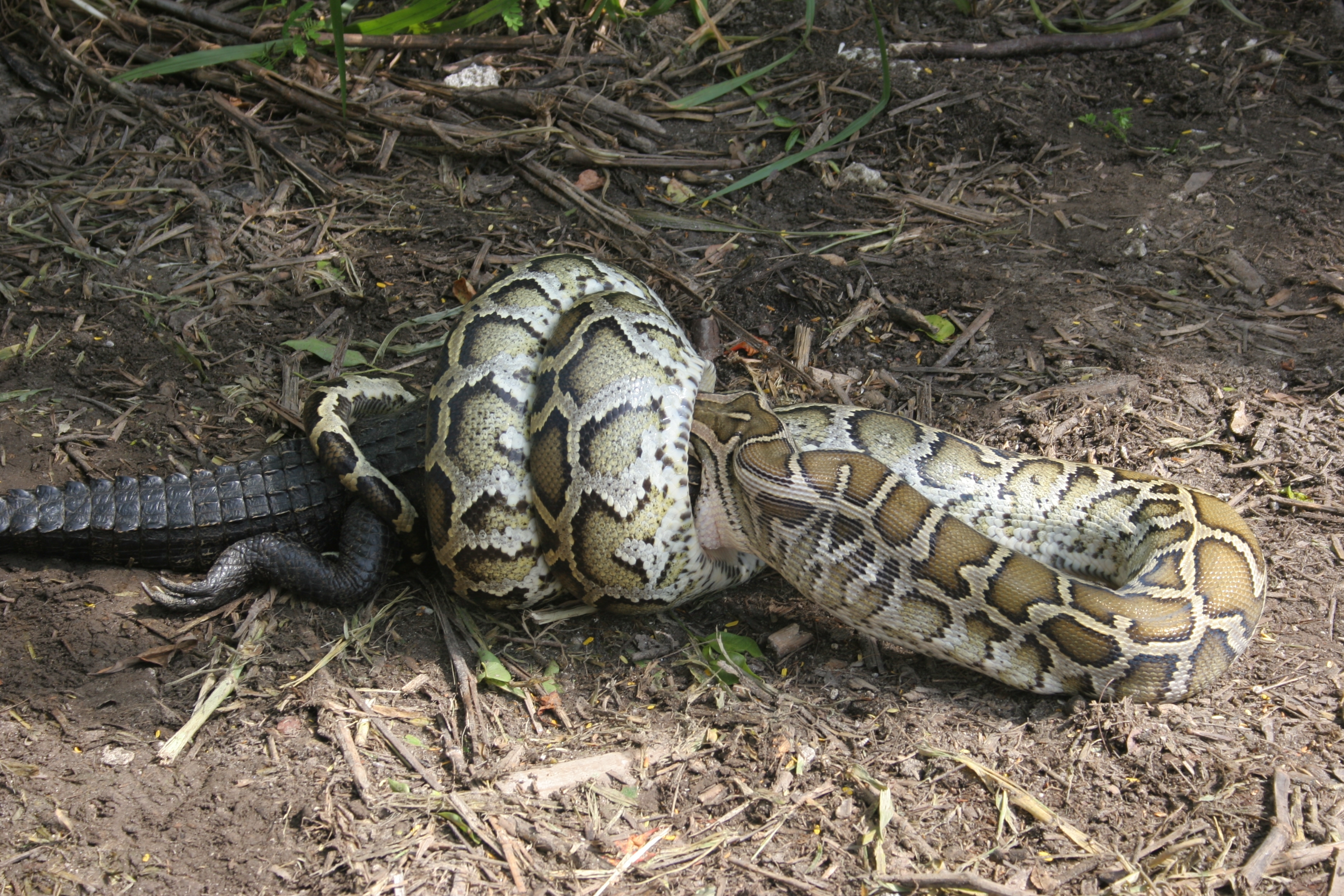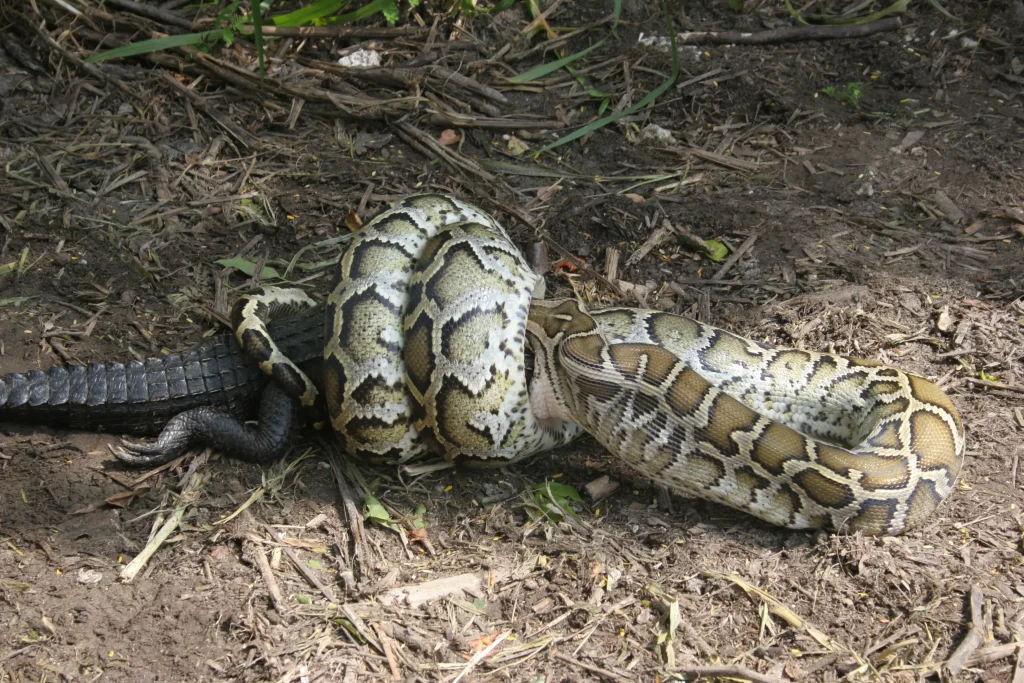The Everglades is an iconic wetland in Florida, known for its diverse wildlife and unique ecosystem. However, in recent years, the area has been facing a serious threat from an invasive species – the Burmese Python. These large snakes, which were originally brought to Florida as pets, have now become a major problem for the Everglades, causing significant damage to the environment and native wildlife.
How Are the Burmese Pythons Damaging the Everglades?
Burmese pythons are not native to the Everglades and were introduced as pets. However, they have since become an invasive species and are causing significant damage to the ecosystem. They prey on native species such as birds, mammals, and reptiles, leading to a decline in their populations. Additionally, they have no natural predators in the area, allowing their populations to grow unchecked. This has led to a disruption in the natural balance of the Everglades and is a significant threat to its biodiversity.

How Are the Burmese Pythons Damaging the Everglades?
The Burmese python, native to Southeast Asia, has become one of the most invasive species in the Florida Everglades. These large snakes, which can grow up to 20 feet long, were first introduced to the area in the 1980s through the exotic pet trade. However, as some owners released their snakes into the wild, the Burmese python population began to grow rapidly, causing significant damage to the fragile ecosystem of the Everglades.
Threat to Native Species
The Burmese python preys on a variety of native species in the Everglades, including birds, mammals, and reptiles. In fact, researchers estimate that the python population has caused a 90% decline in the population of small mammals in the area. This is because the pythons are apex predators, meaning they have no natural predators in the ecosystem and can easily outcompete other species for food.
The python’s diet also includes other reptiles, including endangered species such as the Key Largo woodrat and the eastern indigo snake. This has led to concerns that the Burmese python could cause the extinction of these species in the wild, further disrupting the delicate balance of the Everglades ecosystem.
Disruption of Food Chain
The Burmese python’s impact on the food chain of the Everglades is another major concern. As an apex predator, the python is at the top of the food chain, but its presence in the ecosystem has disrupted the natural balance. Small mammals, which are an important source of food for other predators, have become scarce due to the python’s presence. This has led to a decline in the population of other predators in the area, including bobcats, foxes, and coyotes.
The python’s impact on the food chain also affects the plant life of the Everglades. Many small mammals play a role in seed dispersal, which is essential for the growth and survival of plants in the ecosystem. With fewer small mammals, the dispersal of seeds is disrupted, which can have long-term effects on the plant life of the Everglades.
Spread of Disease
The Burmese python is also known to carry diseases that can be transmitted to other species in the Everglades. One such disease is the snake fungal disease, which can cause skin lesions and respiratory infections in snakes. The spread of this disease among the python population has led to concerns that it could also affect other species in the ecosystem.
In addition to disease, the python’s presence in the Everglades also increases the risk of parasites and other pathogens being introduced to the ecosystem. This can have significant implications for the health and survival of native species in the area.
Human Safety Concerns
The presence of Burmese pythons in the Everglades also poses a safety risk to humans. These large snakes are not venomous, but they are powerful constrictors and can pose a threat to people who come into close contact with them. While attacks on humans are rare, the potential for conflict between humans and pythons is a concern.
In addition to the risk of physical harm, the presence of pythons in the Everglades can also impact the local economy. Tourism is an important industry in the area, and the reputation of the Everglades as a natural wonder could be tarnished by the presence of an invasive species like the Burmese python.
Efforts to Control the Python Population
Efforts to control the Burmese python population in the Everglades have been ongoing for years, but the task is challenging. Pythons are difficult to locate and capture, and their ability to adapt to different habitats makes them resilient to changes in the ecosystem. However, several strategies have been implemented to try to reduce the population of these invasive snakes.
One approach is to use trained dogs to locate and capture pythons in the wild. Another strategy is to hold python-hunting competitions, which encourage locals and tourists to capture as many pythons as possible. These efforts have had some success in reducing the python population, but the task of eradicating them completely remains a daunting challenge.
Benefits of Python Control
While the Burmese python’s impact on the Everglades ecosystem has been significant, efforts to control the population of these snakes could have positive effects. By reducing the python population, other native species in the area could have a chance to recover. This could lead to a restoration of the natural balance of the ecosystem and a return to greater biodiversity.
In addition, controlling the python population could also have economic benefits. The presence of an invasive species like the Burmese python can have a negative impact on the tourism industry in the area. By reducing the python population, the reputation of the Everglades as a natural wonder could be restored, leading to increased tourism and economic growth.
Burmese Python Vs Native Species
The Burmese python’s impact on the native species of the Everglades is significant. As an apex predator, the python has disrupted the natural balance of the ecosystem, leading to declines in the population of small mammals and other predators. This has had long-term effects on the food chain and the plant life of the area.
In addition to its impact on the ecosystem, the python also poses a safety risk to humans and can have negative economic implications for the tourism industry. However, efforts to control the python population could have positive effects, including a restoration of the natural balance of the ecosystem and increased economic growth.
Conclusion
The Burmese python is a significant threat to the delicate ecosystem of the Florida Everglades. Its impact on the native species of the area is significant, and efforts to control the population of these invasive snakes are ongoing. While the task of eradicating them completely remains a challenge, the benefits of python control could be significant, including a restoration of the natural balance of the ecosystem and increased economic growth.
Frequently Asked Questions
How are the Burmese Pythons damaging the Everglades?
The Burmese pythons are a non-native species that was introduced to the Everglades ecosystem as a result of pet owners releasing them into the wild. These snakes have no natural predators in this environment and have been able to thrive and reproduce rapidly, resulting in a significant decline in the native wildlife populations.
The Burmese pythons are known to eat a variety of animals, including deer, raccoons, and birds. This has led to a disruption in the food chain and an imbalance in the ecosystem. The snakes also compete with native predators for food, which has led to a decline in their populations as well. The Burmese pythons are also known to carry diseases that can be harmful to other animals.
What impact are the Burmese Pythons having on the Everglades ecosystem?
The Burmese pythons are having a significant impact on the Everglades ecosystem. Their presence has led to a decline in the populations of native species, which has a ripple effect throughout the ecosystem. The snakes are known to eat a variety of animals, including those that play important roles in the food chain.
The Burmese pythons have also been known to cause harm to other animals through the spread of diseases. In addition, the snakes compete with native predators for food, which has led to a decline in their populations as well. The Burmese pythons have disrupted the natural balance of the Everglades ecosystem and continue to be a major problem for conservationists.
What is being done to control the Burmese Python population in the Everglades?
Several measures have been put in place to control the Burmese Python population in the Everglades. These include the use of traps and the implementation of hunting programs. Traps are used to capture the snakes and remove them from the ecosystem.
The hunting programs allow licensed individuals to hunt the snakes, with the goal of reducing their numbers. Researchers are also working to develop new methods of controlling the Burmese Python population, including the use of pheromones to attract the snakes to traps. These efforts are ongoing, and conservationists are working to develop new strategies to address this problem.
Why are the Burmese Pythons so successful in the Everglades?
The Burmese pythons are successful in the Everglades for several reasons. One of the main reasons is that they have no natural predators in this environment. This allows them to reproduce rapidly and establish themselves as a dominant species.
In addition, the Everglades provide a favorable habitat for the snakes. The warm, humid climate provides ideal conditions for the snakes to thrive and reproduce. The snakes are also able to find ample food sources in the Everglades, which contributes to their success.
What can people do to help protect the Everglades from the Burmese Pythons?
There are several things that people can do to help protect the Everglades from the Burmese pythons. One of the most important things is to avoid releasing exotic pets into the wild. This is how the Burmese pythons were introduced to the ecosystem in the first place.
People can also help by reporting any sightings of Burmese pythons in the Everglades. This information can help researchers and conservationists better understand the extent of the problem and develop new strategies for controlling the population. Finally, people can support conservation efforts in the Everglades by volunteering, donating, or spreading awareness about the issue.
Burmese Pythons Taking over the Everglades
In conclusion, the Burmese pythons have become a serious threat to the delicate ecosystem of the Everglades. These invasive species have no natural predators and are capable of consuming large prey, including native mammals and birds. They are also known to carry diseases that can infect the native wildlife. As a result, the population of native species has declined significantly, leading to a disruption of the food chain.
The Burmese pythons have also affected the economy of the region. The Everglades is a popular tourist destination, but the infestation of these snakes has created a sense of fear among visitors. It has also affected the fishing industry, as the pythons have been known to consume large numbers of fish, causing a decline in fish populations.
Efforts are underway to control the spread of the Burmese pythons. The Florida Fish and Wildlife Conservation Commission has launched a program to remove these snakes from the Everglades. The program includes tracking the snakes, capturing them, and euthanizing them. The commission is also working on educating the public about the dangers of releasing exotic pets into the wild.
Overall, it is important to recognize the impact that invasive species can have on the environment. The Burmese pythons have caused significant damage to the Everglades, but with continued efforts, we can work towards restoring the delicate balance of this unique ecosystem.


